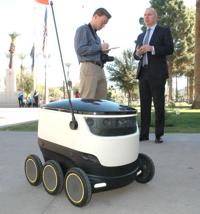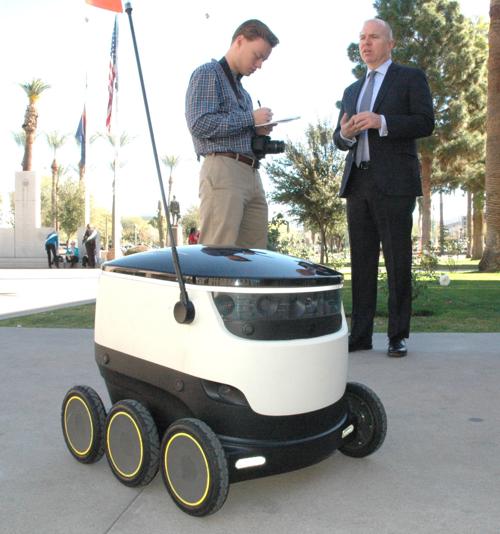PHOENIX — They don’t have the personality of WALL-E, or even the communication skills of that small waste-collecting robot of Pixar film fame, but small, six-wheeled robots could begin delivering everything from lunches to groceries to mall purchases in Arizona.
State lawmakers took the first steps Wednesday to legalizing use of “personal delivery devices.”
House Bill 2422, given unanimous approval by the House Committee on Transportation and Infrastructure, would specifically allow the robots to operate on sidewalks and in crosswalks. The measure needs full House approval next before going to the Senate.
The bill would give the delivery devices the same rights and duties as pedestrians, with whom they would share the right of way. That includes a mandate to follow all traffic and pedestrian control signals and devices.
That’s already happening in the San Francisco and Washington, D.C., areas as well as in several countries in Europe, said David Catania, a spokesman for Estonia-based Starship Technologies.
In some cases, he said, customers lease the robots outright, keeping them around for errands as necessary. Catania said other customers call on them as necessary, much in the same way someone might call for an Uber.
Catania told lawmakers that the devices won’t be a danger to pedestrians or impair movement on sidewalks, even if there are several of them running around.
First, he said, they’re no wider than a typical pedestrian. They are programmed to avoid confrontations.
“They have a bubble of awareness of about 15 meters using sonic sensors and cameras,” Catania explained while demonstrating the robot outside the Capitol on Wednesday. “So they’ll actually see the person before, in many cases, the person will see it, especially as many people are constantly on their cellphones.”
The shins of pedestrians are also in no danger, he said. “It will get within 18 inches and then it will stop.”
If it confronts something, or someone, that does not move, Catania said it is programmed to try to find its way around. And if it finds itself surrounded by pedestrians, he said it slows from its top programmed speed of about 4 miles per hour to match the pace of everyone else.
The Arizona legislation would allow the robots to go as fast as 10 miles an hour, about three times as fast as the average person normally walks.
Catania said each device effectively “learns” the streets along its routes by being led around for the first time by a human. After that, it should be pretty much automatic.
But Catania said there is always a human the robot can “ping” through the cellphone network in case of troubles, such as hitting something or coming to an intersection with a lot of traffic. At that point, he explained, a human could take over and help navigate around or through the problem using the onboard cameras.
The devices can go between two and three hours on a single charge. Catania said the focus is on deliveries in the neighborhood of 1ƒ miles, and the robots probably have an effective range of about 2 miles.
From an environmental perspective, Catania said it makes more sense to have small deliveries — the estimated capacity is about 20 pounds — made by one of these devices rather than sending out a big gasoline- or diesel-powered truck.
There are even more creative opportunities, Catania told lawmakers.
He said the firm has a partnership with Mercedes which allows eight of these robots to be parked in the bottom of a van, “park it in a neighborhood and deliver 100 packages in the span of a day without the truck ever moving, which is a great benefit, candidly, for traffic congestion and pollution.”
He said there are security measures built in, both to protect the robot and its contents.
On the latter, he said the system is set up so that the person expecting a delivery is texted when the robot arrives. Only then will the storage compartment unlock.
As to stealing the device, Catania said that would not be easy. Aside from it weighing 80 pounds, he said there are “redundant GPS systems” to report its location.
“So we’ll be able to find it,” he said.
The legislation would require those who operate the devices to have at least $100,000 of liability insurance to cover injuries or damages. Catania said that in the company’s history it has had only one claim.
Rep. David Cook, R-Globe, had a slightly different liability question.
“As someone who’s got a 19-year-old and a 17-year-old that drive, and they run over this thing ... I want to know what it’s going to cost to replace it,” he said.
Catania said the first models — there are about 150 now deployed — cost something under $10,000 to manufacture. But he said once there is a demand for more the price tag can get down to about the $1,000 range.





